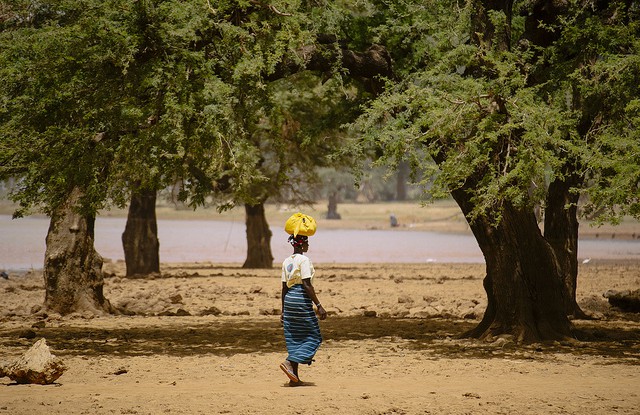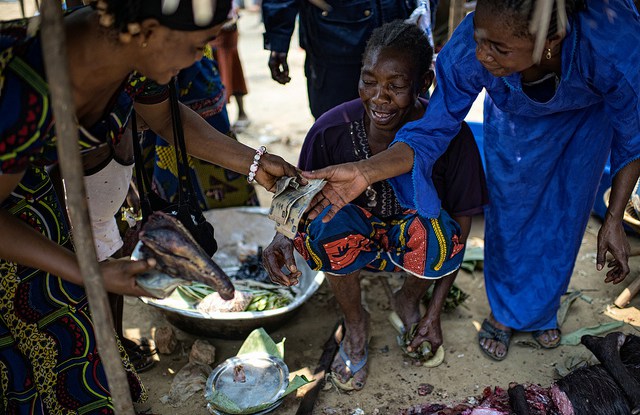
An integrated approach to land management ensuring sustainable policies could help agriculture-dependent West Africa cope with the looming effects of climate change, a panel of experts proposed.
Climate change is already affecting the livelihoods of West African smallholder farmers who rely on rain-fed agricultural techniques, and it is expected to make food shortages more acute as the region’s population continues to grow, said panelists at an event at the Global Landscapes Forum (GLF), on the sidelines of the recent U.N. climate talks in Warsaw, Poland.
Farmers in the region are trying to cope with irregular rainfall, flooding and degraded soil, and we must recognize the potential to reduce some of the effects of climate variability and change, said Robert Zougmoré, West Africa Regional Leader with the CGIAR Research Program on Climate Change, Agriculture and Food Security (CCAFS).
“The West Africa region is very poor and vulnerable to all kinds of threats,” Zougmoré said. “The greater challenge is to increase agricultural production among resource-poor farmers while taking into consideration adaptation and without exacerbating environmental health — the two new dimensions of climate change.”
THREATS IN WEST AFRICA
A recent report by the International Food Policy Research Institute (IFPRI), “West African Agriculture and Climate Change: A Comprehensive Analysis,” lays out the challenges faced in a region where agriculture makes up 35 percent of GDP and employs 60 percent of the population.
Projections show that mean temperatures in West Africa will rise by 2 degrees Celsius (3.6 Fahrenheit) by 2050, with one climate model predicting an increase of 3.5 degrees C. Although there is no definitive projection for future precipitation levels, data anticipate variations in rainfall, with reductions seen along the coast.
In the coastal West African countries of Ghana, Togo, Benin and Nigeria, such important crops as maize, groundnut and sorghum could be hurt by dryer weather. Conversely, flooding exacerbated by weak infrastructure could lead to the spread of disease in humans and livestock, causing food prices to rise, said Zougmoré, an agronomist who specializes in production ecology and resource conservation.
Panellists discussed western, eastern and southern Africa, considering how climate change would make some areas better and some worse for agricultural production. They also discussed other downsides of climate change — the potential for mass internal migration and land grabs if appropriate policies are not in place.
It’s important to consider all related components of how a landscape will look, for whom it needs to work and how it needs to function to ensure sustainability
The IFPRI report “should help policymakers to understand the different options for the future,” he said. “They can consider it and proceed to good planning that will help decide how to tackle these issues in the immediate future and in the long term.”
A ‘LANDSCAPES’ SOLUTION?
Long-term planning was at the forefront of the panel discussion at the GLF event in Warsaw. A “landscapes approach,” which takes a holistic, integrated attitude toward improved land management, could help establish sustainable development strategies to help in the effort to adapt to and mitigate climate change, panelists proposed.
“People do not live in separate land-use sectors; they live holistically, as part of the fabric of their surroundings — or landscape,” said Terry Sunderland, a principal scientist with the Center for International Forestry Research (CIFOR) who co-authored “Ten principles for a landscape approach to reconciling agriculture, conservation, and other competing land uses.”
The 10-point “code of practice” for managing landscapes is intended to serve as a loose framework to help policymakers, non-governmental organizations (NGOs), and conservation and development practitioners to develop and improve land-use planning policies.
“It’s important to consider all related components of how a landscape will look, for whom it needs to work and how it needs to function to ensure sustainability,” Sunderland said.
This includes cooperation at multiple levels. “We need to discuss climate change at a very local level as well as the national level,” added Zougmoré. To that end, he said, CCAFS is working with a “climate-smart” village concept, which involves researchers, public extentionists, NGOs and farmers, so that risks faced by stakeholders — especially farmers — can be considered in plans for land management.
“At the regional level it’s vitally important to consider the key challenges for policy decision making as well as policy planning.”
CHALLENGES REMAIN
The difficulty with the landscapes approach is that there is no map that can show how the world is divided into landscapes, said Timothy Thomas, research fellow of environment and production technology with IFPRI.
Moreover, a landscapes approach cannot account for future unknowns. A key component of planning for the future involves creating land-use models to try to predict where best to plant crops and to try to determine which ones will be most productive, Thomas said.
“If somebody is cultivating a crop now, and can’t in the future, that’s bad, but maybe you can switch to a new crop — maybe technology will develop a resistant crop,” he said. “If I were going to be a policymaker in 2050, I would look at options to see whether species varieties can be developed that will do well in droughts and in floods, and that are resilient.”
For further information on the topics discussed in this article, please contact Terry Sunderland at t.sunderland@cgiar.org
We want you to share Forests News content, which is licensed under Creative Commons Attribution-NonCommercial-ShareAlike 4.0 International (CC BY-NC-SA 4.0). This means you are free to redistribute our material for non-commercial purposes. All we ask is that you give Forests News appropriate credit and link to the original Forests News content, indicate if changes were made, and distribute your contributions under the same Creative Commons license. You must notify Forests News if you repost, reprint or reuse our materials by contacting forestsnews@cifor-icraf.org.
